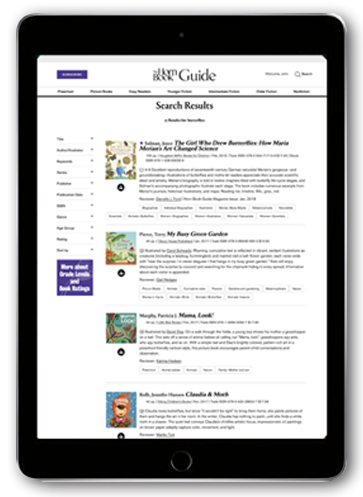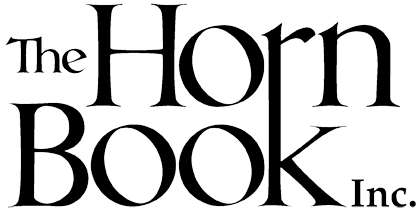Related
654 Reviews
(4)
K-3
Illustrated by
Ben Hodson.
Animals, ghosts, and dudes introduce long vowel sounds with short rhyming phrases: "Cave Bear. / Wave Bear. / Lazy Bear. / Crazy Bear." Rather than introducing its section where it might be most helpful, the relevant reading tip ("Long vowels say their own names") follows the content. Busy cartoon illustrations extend the limited text and help lessen the book's purposeful intent.
Reviewer: Rebecca Reed Whidden
(4)
K-3
Cloverleaf Books: Alike and Different series.
Illustrated by
Paula Becker.
Romelie hears a lot of different languages around her neighborhood. New kid Camila speaks Spanish; brother Theo uses sign language; Mom says that "many place-names in the United States come from American Indian languages"; a family at the park speaks Hmong. Accompanied by cheerful cartoon illustrations, this is an appealing if limited introduction. An American Sign Language visual is appended. Reading list, websites. Glos., ind.
Reviewer: Kitty Flynn
(4)
K-3
Words Are Categorical series.
Illustrated by
Martin Goneau.
Cleary's colorful cats coach the concept (see what we did there?) of alliteration for elementary-age readers. This is Cleary's usual schtick: forced rhymes introduce a term and provide examples, ad infinitum, while the cartoon cats provide exaggerated comic relief in the garishly hued illustrations. Alliterative words are highlighted in the text to aid comprehension. A final chart with examples reinforces lessons learned.
Reviewer: Kitty Flynn
(4)
K-3
Illustrated by
Jim Paillot.
Abundant examples, highlighted in a bold font throughout Cleary's uninspired rhyming narrative, reinforce proper usage of the homophones they're, there, and their. Cartoon illustrations drive home the absurdity of the Tuckabee family's vacation, which features stops to see the World's Largest Underwear and the Cheezie Popz factory. A concluding page summarizes the functions of each member of the homophone triplet.
Reviewer: Rebecca Fox
(4)
K-3
Punctuation Station series.
Illustrated by
Anthony Lewis.
Through a brief story, each book demonstrates multiple uses of one punctuation mark: Ahmed, for instance, uses exclamation points when he makes the soccer team (Exciting!). Different-color type effectively highlights each in-text use of the featured punctuation mark. The stories are slight, but the repeat characters' enthusiastic, friendly faces may engage readers. A list of each mark's key functions is appended. Review covers these Punctuation Station titles: "What Did You Say?", Stop Right There., Take a Pause, Paul, This Is Exciting, We're Going to the Smiths' House, and What Is That?.
Reviewer: Rebecca Fox
(3)
K-3
In this Spanish-language (text not evaluated) edition, Enriqueta's mom gives her colored pencils, and she creates a thrilling story about a girl named Emilia and the monster who comes out of her wardrobe. Emilia's adventure is drawn with colored pencils--brightly colored, messy, dramatic scrawls; contrastingly neat, contained panels in pen-and-ink and watercolor show Enriqueta drawing and commenting on the story's progress. Concurrently published in English.
Reviewer: Martha V. Parravano
(4)
K-3
After her students attempt to spell a word, Ms. Spell produces the answer through magic (e.g., "Chicken lips and earthworm hair, / spelling stick, please show us their!"). Thwarting this clearheaded book's mission to elucidate is its chaotic presentation: the cartoonish art features panels, dialogue balloons, asides to the reader ("They're is a contraction that means 'they are'"), and more.
Reviewer: Nell Beram
(4)
K-3
Vowels series.
Each formulaic, easy-to-read title introduces sounds (long or short) and placements (at the beginning, middle, or end of a word) of a specific vowel. The vowel's unique features are also highlighted (e.g., "A can even be a word by itself"). Bright, full-page stock photos accompany the approachable language-arts lessons, but the books don't rise above their intended purpose. Review covers these Vowels titles: What Good Is a U?, What Good Is a Y?, What Good Is an A?, What Good Is an E?, What Good Is an I?, and What Good Is an O?.
Reviewer: Rebecca Fox
(4)
K-3
Vowels series.
Each formulaic, easy-to-read title introduces sounds (long or short) and placements (at the beginning, middle, or end of a word) of a specific vowel. The vowel's unique features are also highlighted (e.g., "A can even be a word by itself"). Bright, full-page stock photos accompany the approachable language-arts lessons, but the books don't rise above their intended purpose. Review covers these Vowels titles: What Good Is a U?, What Good Is a Y?, What Good Is an A?, What Good Is an E?, What Good Is an I?, and What Good Is an O?.
Reviewer: Rebecca Fox
(4)
K-3
Vowels series.
Each formulaic, easy-to-read title introduces sounds (long or short) and placements (at the beginning, middle, or end of a word) of a specific vowel. The vowel's unique features are also highlighted (e.g., "A can even be a word by itself"). Bright, full-page stock photos accompany the approachable language-arts lessons, but the books don't rise above their intended purpose. Review covers these Vowels titles: What Good Is a U?, What Good Is a Y?, What Good Is an A?, What Good Is an E?, What Good Is an I?, and What Good Is an O?.
Reviewer: Rebecca Fox
(4)
K-3
Vowels series.
Each formulaic, easy-to-read title introduces sounds (long or short) and placements (at the beginning, middle, or end of a word) of a specific vowel. The vowel's unique features are also highlighted (e.g., "A can even be a word by itself"). Bright, full-page stock photos accompany the approachable language-arts lessons, but the books don't rise above their intended purpose. Review covers these Vowels titles: What Good Is a U?, What Good Is a Y?, What Good Is an A?, What Good Is an E?, What Good Is an I?, and What Good Is an O?.
Reviewer: Rebecca Fox
(4)
K-3
Vowels series.
Each formulaic, easy-to-read title introduces sounds (long or short) and placements (at the beginning, middle, or end of a word) of a specific vowel. The vowel's unique features are also highlighted (e.g., "A can even be a word by itself"). Bright, full-page stock photos accompany the approachable language-arts lessons, but the books don't rise above their intended purpose. Review covers these Vowels titles: What Good Is a U?, What Good Is a Y?, What Good Is an A?, What Good Is an E?, What Good Is an I?, and What Good Is an O?.
Reviewer: Rebecca Fox
(4)
K-3
Vowels series.
Each formulaic, easy-to-read title introduces sounds (long or short) and placements (at the beginning, middle, or end of a word) of a specific vowel. The vowel's unique features are also highlighted (e.g., "A can even be a word by itself"). Bright, full-page stock photos accompany the approachable language-arts lessons, but the books don't rise above their intended purpose. Review covers these Vowels titles: What Good Is a U?, What Good Is a Y?, What Good Is an A?, What Good Is an E?, What Good Is an I?, and What Good Is an O?.
Reviewer: Rebecca Fox
(4)
K-3
Punctuation Station series.
Illustrated by
Anthony Lewis.
Through a brief story, each book demonstrates multiple uses of one punctuation mark: Ahmed, for instance, uses exclamation points when he makes the soccer team (Exciting!). Different-color type effectively highlights each in-text use of the featured punctuation mark. The stories are slight, but the repeat characters' enthusiastic, friendly faces may engage readers. A list of each mark's key functions is appended. Review covers these Punctuation Station titles: "What Did You Say?", Stop Right There., Take a Pause, Paul, This Is Exciting, We're Going to the Smiths' House, and What Is That?.
Reviewer: Rebecca Fox
(4)
K-3
Punctuation Station series.
Illustrated by
Anthony Lewis.
Through a brief story, each book demonstrates multiple uses of one punctuation mark: Ahmed, for instance, uses exclamation points when he makes the soccer team (Exciting!). Different-color type effectively highlights each in-text use of the featured punctuation mark. The stories are slight, but the repeat characters' enthusiastic, friendly faces may engage readers. A list of each mark's key functions is appended. Review covers these Punctuation Station titles: "What Did You Say?", Stop Right There., Take a Pause, Paul, This Is Exciting, We're Going to the Smiths' House, and What Is That?.
Reviewer: Rebecca Fox
(4)
K-3
Punctuation Station series.
Illustrated by
Anthony Lewis.
Through a brief story, each book demonstrates multiple uses of one punctuation mark: Ahmed, for instance, uses exclamation points when he makes the soccer team (Exciting!). Different-color type effectively highlights each in-text use of the featured punctuation mark. The stories are slight, but the repeat characters' enthusiastic, friendly faces may engage readers. A list of each mark's key functions is appended. Review covers these Punctuation Station titles: "What Did You Say?", Stop Right There., Take a Pause, Paul, This Is Exciting, We're Going to the Smiths' House, and What Is That?.
Reviewer: Rebecca Fox
(4)
K-3
Punctuation Station series.
Illustrated by
Anthony Lewis.
Through a brief story, each book demonstrates multiple uses of one punctuation mark: Ahmed, for instance, uses exclamation points when he makes the soccer team (Exciting!). Different-color type effectively highlights each in-text use of the featured punctuation mark. The stories are slight, but the repeat characters' enthusiastic, friendly faces may engage readers. A list of each mark's key functions is appended. Review covers these Punctuation Station titles: "What Did You Say?", Stop Right There., Take a Pause, Paul, This Is Exciting, We're Going to the Smiths' House, and What Is That?.
Reviewer: Rebecca Fox
(4)
K-3
Punctuation Station series.
Illustrated by
Anthony Lewis.
Through a brief story, each book demonstrates multiple uses of one punctuation mark: Ahmed, for instance, uses exclamation points when he makes the soccer team (Exciting!). Different-color type effectively highlights each in-text use of the featured punctuation mark. The stories are slight, but the repeat characters' enthusiastic, friendly faces may engage readers. A list of each mark's key functions is appended. Review covers these Punctuation Station titles: "What Did You Say?", Stop Right There., Take a Pause, Paul, This Is Exciting, We're Going to the Smiths' House, and What Is That?.
Reviewer: Rebecca Fox
(4)
K-3
Kokí hates doing work, but when he is caught in a flood and transformed into a frog, the only way to turn back into a child is to help the frog village with chores. Rodriguez's slick, cartoony illustrations are filled with bold colors and humorous details (such as "piratas," who are actually rats), but the heavy-handed moral weakens this Spanish-language tale.
Reviewer: Siena Leslie
(3)
K-3
Illustrated by
Jago.
"Would a labor of moles / wear polka-dot ties / when it goes to work / for a business of flies?" Rhyming text features the proper collective noun terms (which may require some adult explanation) for thirty-three animal groups. Textured illustrations of often-personified animals will help readers pick up on the wordplay and enjoy the text's humor. Glos.
Reviewer: Rebecca Fox
654 reviews
We are currently offering this content for free. Sign up now to activate your personal profile, where you can save articles for future viewing.






















